The ASUS Republic of Gamers G751 Review: G-SYNC Comes To The Notebook Computer
by Brett Howse on July 29, 2015 8:30 AM ESTSystem Performance
To start on the performance section, let’s take a look at how the ASUS G751 performs when running applications on the desktop. Powering the ASUS G751 model that was shipped for review is the Intel Core i7-4720HQ processor. At this point in the life of the fourth gen Core i7 processors, it may seem out of date, but the i7-4720HQ was actually just launched in Q1 2015. It is a quad-core, eight-thread processor with a base frequency of 2.6 GHz and turbo of 3.6 GHz. The maximum turbo is held in check by the 47 watt thermal design point, which is at the top end of the mobile processor range from Intel. It would have been nice to see ASUS move to Broadwell, but the quad-core mobile parts will likely be short lived anyway and have certainly been a long time coming.
With 24 GB of memory, the dual-channel memory is not balanced, with 8 GB on one channel and 16 GB on the other. ASUS does offer a model with a full 32 GB, or you can always order another stick of DDR3L-1600 if you want to change that. But as we will see in the scores below, performance is not impacted by this very much if at all, especially since the bandwidth-hungry iGPU is going unused.
Storage is a strong point on the ASUS G751, with ASUS being one of the first companies to start moving to PCIe based SSDs. The XP941 can achieve speeds over 1 GB/s, and while it has been surpassed by the Samsung SM951, it’s still a solid and quick PCIe SSD.
To take a look at general performance, the G751 was put through our laptop workloads. The graphs include other similar devices for comparison, but if you would like to compare the G751 against any other device we have tested, please check out our Notebook Bench.
PCMark
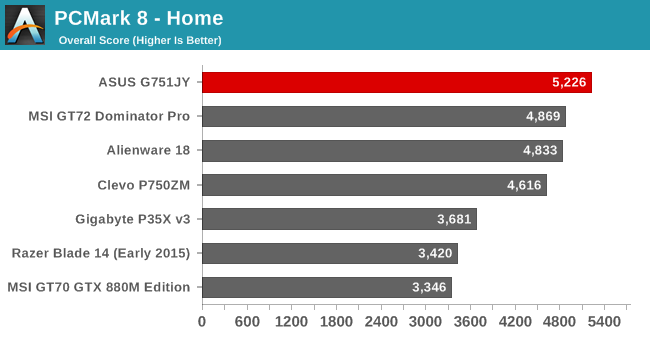
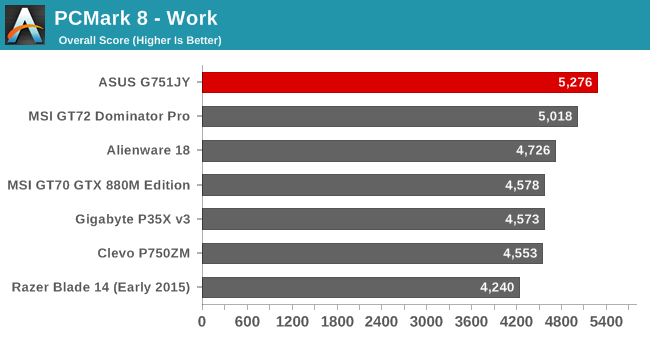

PCMark attempts to replicate real life workloads, and has several different tests which focus on specific workloads. The G751 performs very well in these tests, scoring the highest of any notebook we’ve tested. Since this is a comprehensive benchmark, the CPU is part of the equation, but so is the GPU, display resolution, and storage speed. ASUS has created a pretty well rounded notebook here.
Cinebench
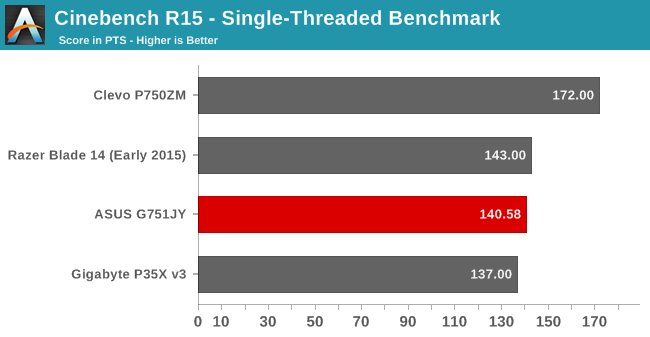
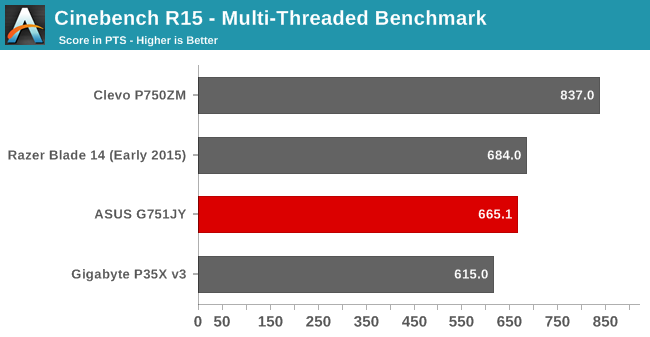
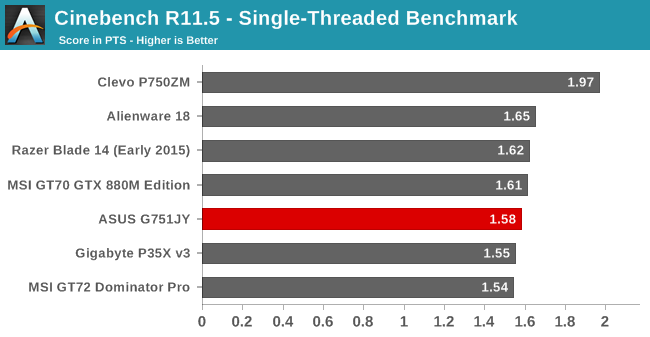
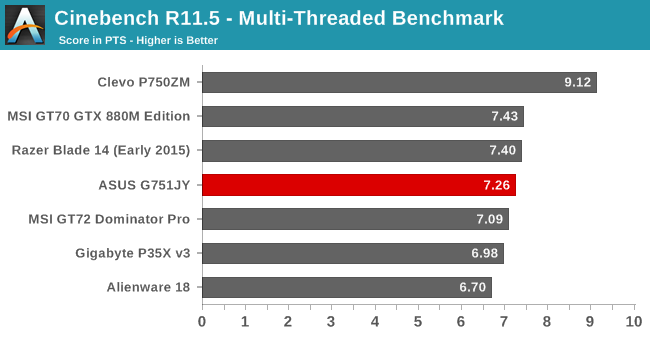
Cinebench tests the ability for the CPU to render an image, and it loves high frequencies and plenty of instructions per clock. The Core i7-4720HQ is fairly powerful in this test, and falls in line with scores similar to other notebooks that have a similar processor. The Clevo has a desktop class 88 watt processor, and runs away in this benchmark.
x264
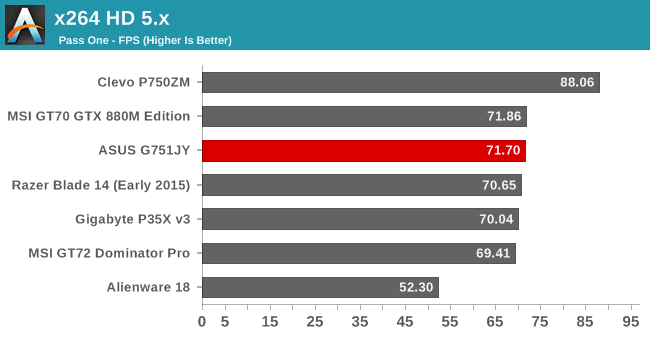
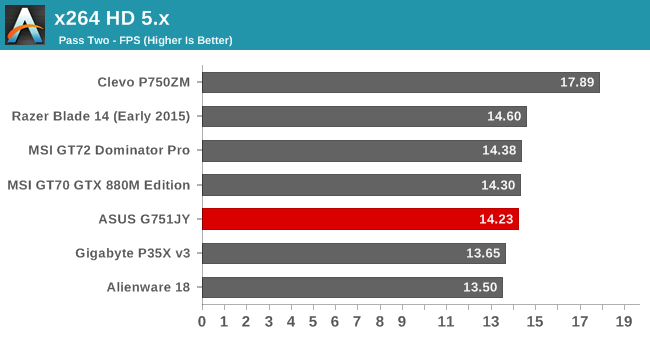
Much like Cinebench, the processor is the key to this score, and once again the i7-4720HQ performs right where you would expect it to, and the Clevo’s desktop processor once again reigns at the top.
Web Tests
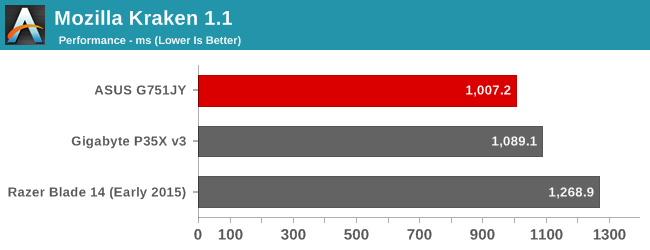
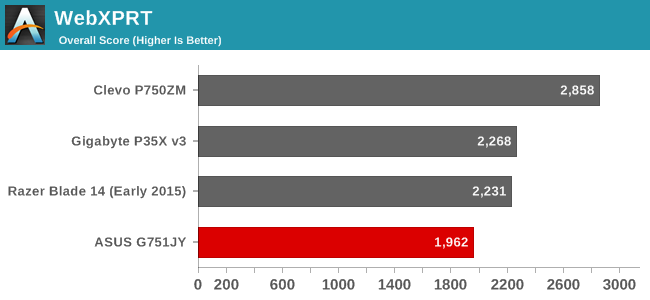
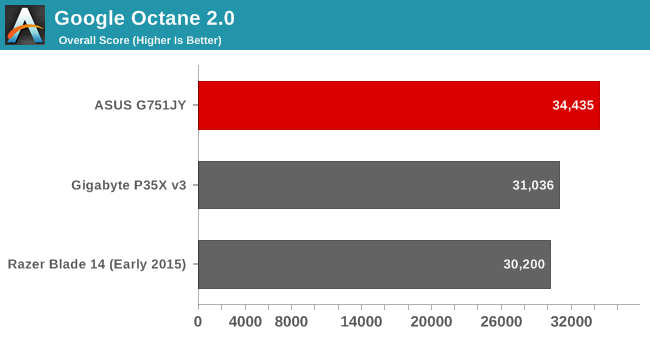
None of the laptops listed are going to struggle with web performance, but it is still handy to see where a fast quad-core system sits. The G751 performs well in the javascript benchmarks using Chrome as the browser. When Windows 10 ships, we can start to move over to Edge as the browser for our web tests.
Storage
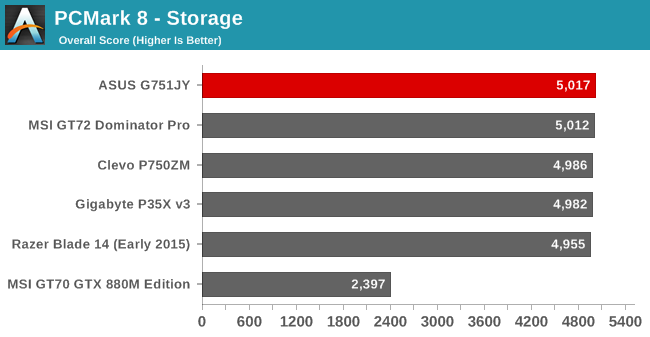
The PCMark Storage test runs traces on a couple of different workloads, but it tends to lump pretty much all SSDs fairly close together, so I’ve also added the CrystalMark Disk benchmark to give a quick glance at the speeds that the G751 can achieve with its PCIe based SSD. It’s been a while since we’ve tested a notebook with a disk based hard drive, so I thought it would be good to test the storage drive as well just so we don’t forget why we’ve moved to SSDs.



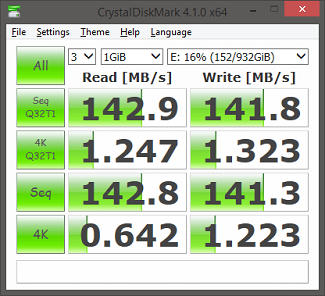








52 Comments
View All Comments
nathanddrews - Wednesday, July 29, 2015 - link
Does Intel plan on taking advantage of the Adaptive Sync tech anytime soon? I know they use it for other things for power saving (self-refresh, etc.), but it sure seems like a golden opportunity.In the same vein - given that we know (and have known for some time) that the G-Sync module is not required if you have eDP/DP1.2a, when can we expect a shift to tech-agnostic displays? Do we have to wait for DP1.3?
DanNeely - Wednesday, July 29, 2015 - link
I know eDP/DP1.2a provides a similar feature set to G-Sync; but has nVidia actually said anything about adopting it instead of (in addition to?) their current custom hardware implementation?DanNeely - Wednesday, July 29, 2015 - link
I suppose I deserve what I get for commenting before reading the 2nd page of the article; but as long as they're requiring additional qualification work to approve a panel for GSync, there's still plenty of potential to cause trouble for cross GPU support if they wanted to.nathanddrews - Wednesday, July 29, 2015 - link
VESA's Adaptive Sync is a part of eDP and DP 1.2a+. It's there, waiting to be used. G-Sync, FreeSync, and whatever Intel does are just the names for how they utilize it.The only reason NVIDIA pursued a custom module was because no desktop monitors - at the time - included A-Sync. Screens connected via eDP can. As we move forward with newer and newer displays, we're likely to see more and more of them be A-Sync-capable, which means being able to support any variable refresh technology, whatever the marketing label is. Whether or not those displays end up as G-Sync, FreeSync, or some sort of hybrid is up to the manufacturers, I suppose. Just like with G-Sync and FreeSync displays, optimizing the display will still be important.
Ideal situation: connect monitor to computer, GPU drivers load a default profile based upon EDID for frequency range and resolution support, advanced users can tweak (under/overclock/etc.), maybe share firmware, etc. to crowd-source calibration settings. Shipping a monitor back to a manufacturer for an update is ridiculous...
lefty2 - Thursday, July 30, 2015 - link
> The only reason NVIDIA pursued a custom module was because no desktop monitors - at the time - included A-Sync.This is not true. When AMD created FreeSync the DisplayPort 1.2a monitors did not exist either, but instead of creating a propierty solution, they got FreeSync incorperated into the open standard. Nvidia could have done the same thing, but they prefer using propierty standards to lock the customers in.
nathanddrews - Thursday, July 30, 2015 - link
Interesting version of history you've created.DP1.2a display availability lagged behind G-Sync Module display availability by more than a year. If NVIDIA pursued the VESA solution, G-Sync would have been delayed alongside FreeSync. The G-Sync module was absolutely required to get a jump on the market since DP1.2 did not include the Adaptive Sync option. You may not LIKE it, but that's the how it happened.
lefty2 - Thursday, July 30, 2015 - link
DP1.2a display availability also lagged behind FreeSync... AMD just waited had to wait for them to come available (in fact they pushed the standard forward) and Nvidia could have done the same.LoganPowell - Friday, November 27, 2015 - link
ASUS does overall make fantastic computers, but I'd recommend going for the Dell Inspiron i7559-763BLK. Highly approved by many gaming enthusiasts. /Logan from http://www.consumerrunner.com/top-10-best-laptops/Creig - Thursday, July 30, 2015 - link
"additional qualification" = give us money to use the G-sync name.Shadowmaster625 - Wednesday, July 29, 2015 - link
I have a great idea. Let's build Optimus notebooks for five years, and then all the sudden build one without it! Isnt that a great frickin idea? I need to be CEO of Asus.